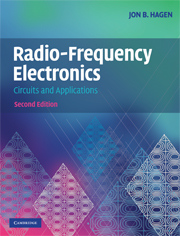Book contents
- Frontmatter
- Contents
- Preface
- 1 Introduction
- 2 Impedance matching
- 3 Linear power amplifiers
- 4 Basic filters
- 5 Frequency converters
- 6 Amplitude and frequency modulation
- 7 Radio receivers
- 8 Suppressed-carrier AM and quadrature AM (QAM)
- 9 Class-C, D, and E Power RF amplifiers
- 10 Transmission lines
- 11 Oscillators
- 12 Phase lock loops and synthesizers
- 13 Coupled-resonator bandpass filters
- 14 Transformers and baluns
- 15 Hybrid couplers
- 16 Waveguide circuits
- 17 Small-signal RF amplifiers
- 18 Demodulators and detectors
- 19 Television systems
- 20 Antennas and radio wave propagation
- 21 Radar
- 22 Digital modulation techniques
- 23 Modulation, noise, and information
- 24 Amplifier and oscillator noise analysis
- 25 The GPS Navigation system
- 26 Radio and radar astronomy
- 27 Radio spectrometry
- 28 S-parameter circuit analysis
- 29 Power supplies
- 30 RF test equipment
- Index
- References
20 - Antennas and radio wave propagation
Published online by Cambridge University Press: 05 June 2012
- Frontmatter
- Contents
- Preface
- 1 Introduction
- 2 Impedance matching
- 3 Linear power amplifiers
- 4 Basic filters
- 5 Frequency converters
- 6 Amplitude and frequency modulation
- 7 Radio receivers
- 8 Suppressed-carrier AM and quadrature AM (QAM)
- 9 Class-C, D, and E Power RF amplifiers
- 10 Transmission lines
- 11 Oscillators
- 12 Phase lock loops and synthesizers
- 13 Coupled-resonator bandpass filters
- 14 Transformers and baluns
- 15 Hybrid couplers
- 16 Waveguide circuits
- 17 Small-signal RF amplifiers
- 18 Demodulators and detectors
- 19 Television systems
- 20 Antennas and radio wave propagation
- 21 Radar
- 22 Digital modulation techniques
- 23 Modulation, noise, and information
- 24 Amplifier and oscillator noise analysis
- 25 The GPS Navigation system
- 26 Radio and radar astronomy
- 27 Radio spectrometry
- 28 S-parameter circuit analysis
- 29 Power supplies
- 30 RF test equipment
- Index
- References
Summary
While discussing transmitter and receiver circuitry we did not have to know much about antennas or propagation. It sufficed to know only that a voltage applied to the terminals of a transmitting antenna causes a proportional voltage to appear very shortly thereafter at the terminals of a receiving antenna. To be more exact, it was sufficient to know that everything between the terminals of the two antennas is equivalent to a linear two-port network. Here we will consider the transmission through this propagation link.
When an ac source (transmitter) is connected to an antenna (practically any metal structure) the resulting current has a component that is in phase with the applied voltage. The impedance of the antenna therefore has a real part, a resistance, and draws power from the source. If the antenna is efficient, most of the power flows away from the antenna in the form of (energy-bearing) electromagnetic waves and only a small fraction of the power will be dissipated by ohmic heating of the antenna itself. The impedance will also generally have a nonzero imaginary part, a reactance. If the reactance is zero at the operating frequency the antenna is said to be resonant, just as an RLC circuit is purely resistive at its resonant frequency. An external tuning network (an antenna tuner) can be used to cancel the reactance and also transform the resistance to a value that matches a receiver's input impedance or to a value that draws a desired amount of power from a transmitter.
- Type
- Chapter
- Information
- Radio-Frequency ElectronicsCircuits and Applications, pp. 259 - 277Publisher: Cambridge University PressPrint publication year: 2009



